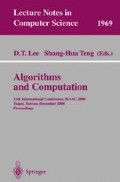Abstract
We describe an algorithm for enumerating all vertices, edges and faces of a planar subdivision stored in any of the usual pointer-based representations, while using only a constant amount of memory beyond that required to store the subdivision. The algorithm is a refinement of a method introduced by de Berg et al (1997), that reduces the worst case running time from O(n 2) to O(n log n). We also give experimental results that show that our modified algorithm runs faster not only in the worst case, but also in many realistic cases.
This research was funded by the Natural Sciences and Engineering Research Council of Canada.
Access this chapter
Tax calculation will be finalised at checkout
Purchases are for personal use only
Preview
Unable to display preview. Download preview PDF.
References
P. A. Burrough. Principles of Geographical Information Systems for Land Resources Assessment. Number 12 in Monographs on Soil and Resources Survey. Clarendon Press, Oxford, 1986.
M. de Berg, M. van Kreveld, R. van Oostrum, and M. Overmars. Simple traversal of a subdivision without extra storage. International Journal of Geographic Information Systems, 11:359–373, 1997.
H. Edelsbrunner, L. J. Guibas, and J. Stolfi. Optimal point location in a monotone subdivision. SIAM Journal on Computing, 15:317–340, 1986.
C. Gold and S. Cormack. Spatially ordered networks and topographic reconstructions. In Proceedings of the 2nd International Symposium on Spatial Data Handling, pages 74–85, 1986.
C. M. Gold, T. D. Charters, and J. Ramsden. Automated contour mapping using triangular element data and an interpolant over each irregular triangular domain. Computer Graphics, 11(2):170–175, 1977.
C. M. Gold and U. Maydell. Triangulation and spatial ordering in computer cartography. In Proceedings of the Canadian Cartographic Association Annual Meeting, pages 69–81, 1978.
Ronald L. Graham, Donald E. Knuth, and Oren Patashnik. Concrete Mathematics. Addison-Wesley, 2nd edition, 1994.
L. J. Guibas and J. Stolfi. Primitives for the manipulation of general subdivisions and the computation of Voronoi diagrams. ACM Transactions on Graphics, 4:74–123, 1985.
D. S. Hirschberg and J. B. Sinclair. Decentralized extrema-finding in circular configurations of processes. Communications of the ACM, 23(11):627–628, 1980.
Kurt Mehlhorn and Stefan Näher. LEDA A Platform for Combinatorial and Geometric Computing. Cambridge University Press, 1999.
D. E. Muller and F. P. Preparata. Finding the intersection of two convex polyhedra. Theoretical Computer Science, 7(2):217–236, 1978.
D. J. Peuquet and D. F. Marble. ARC/INFO: An example of a contemporary geographic information system. In Introductory Readings in Geographic Information Systems, pages 90–99. Taylor & Francis, 1990.
D. J. Peuquet and D. F. Marble. Technical description of the DIME system. In Introductory Readings in Geographic Information Systems, pages 100–111. Taylor & Francis, 1990.
Franco P. Preparata and Michael Ian Shamos. Computational Geometry. Springer-Verlag, New York, 1985.
Author information
Authors and Affiliations
Editor information
Editors and Affiliations
Rights and permissions
Copyright information
© 2000 Springer-Verlag Berlin Heidelberg
About this paper
Cite this paper
Bose, P., Morin, P. (2000). An Improved Algorithm for Subdivision Traversal without Extra Storage. In: Goos, G., Hartmanis, J., van Leeuwen, J., Lee, D.T., Teng, SH. (eds) Algorithms and Computation. ISAAC 2000. Lecture Notes in Computer Science, vol 1969. Springer, Berlin, Heidelberg. https://doi.org/10.1007/3-540-40996-3_38
Download citation
DOI: https://doi.org/10.1007/3-540-40996-3_38
Published:
Publisher Name: Springer, Berlin, Heidelberg
Print ISBN: 978-3-540-41255-7
Online ISBN: 978-3-540-40996-0
eBook Packages: Springer Book Archive

